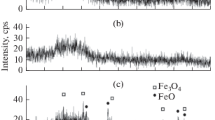Abstract
As X-ray, neutron scattering, and vibrational spectroscopy are not useful for amorphous solids characterization, microprobe analysis is used in determining the composition of these materials. The correlation coefficient matrix between the slag’s elements is obtained by a simple computer program which is commercially available. This matrix is employed for the constitution of the neighborhood of an element, which may be called the “pseudo-structure” (PS). The proposed method is a statistical view of the probable associations between the elements. It gives an insight into the amorphous solids' structure. The lixiviation of tin slags in order to recover the refractory metals they contain is used to illustrate the importance of the PS. A multistage acid-basic (AB) leaching leads to the dissolution of the matrix composed of Ca, Al, Fe, Mn, Si, ... oxides and the concentration of refractory metal oxides in the residues. The optimum tantalum and niobium recovery rates are 93 and 78 pct, respectively. The results of this research indicate that the leaching of the amorphous tin slag is a structure-sensitive operation. However, one may emphasize that the PS of amorphous solids is a simplification of the real neighborhood of ele-ments. It may be considered as a complement to other methods of investigation of the amorphous solids and may facilitate the hydrometallurgical process planning.
Similar content being viewed by others
References
P.H. Gaskell:Amorphous Materials, Symp. Proc., St. Louis, MO, Oct. 1982, V. Viitek, ed., TMS-AIME, Warrendale, PA, 1983, p. 47.
G. Seaborg:Metall. Trans. A, 1980, vol. 11A, pp. 5–19.
Larry D. Cunningham:Columbium and Tantalum, Minerals Yearbook, United States Department of the Interior, Bureau of Mines, 1987, vol. 1, pp. 279-88.
M.K. Malau: Thesis, Institut National Polytechnique de Lorraine, France, 1986.
B. De Albuquerque: Thesis, Imperial College of Science and Technology, United Kingdom, 1983.
M.C. Marignac:Ann. Chim. Phys., 4th series, 1866, vol. 8, pp. 49–75.
P. Borchers and G.J. Korinek:Proc. Extractive Metallurgy of Refractory Metals, Chicago, IL, Feb. 1981, H.Y. Sohn, ed., TMS-AIME, Warrendale, PA, pp. 95–106.
Dong Hui Lee:J. Korean Inst. Min. Mining Eng., 1982, vol. 19, pp. 209–14.
I. Gaballah:Proc. 1st Int. Conf. on Hydrometallurgy, ICHM '88, Beijing, Oct. 1988, Y. Zheng and J.G. Xu, eds., International Academic Publishers, Beijing, pp. 695–98.
Chemical Engineering's Handbook, R.H. Perry and C.H. Chilton, eds., McGraw-Hill Book Company, New York, NY, 1973.
V.G. Chukhlantsev, P.V. Dyunov, and A.N. Zelikman:Zh. Prikl. Khim., 1974, vol. 47 (7), pp. 1466–69.
D.H. Declerck and A.J. Patarcity:Chem. Eng., 1986, vol. 93 (22), pp. 46–63.
Author information
Authors and Affiliations
Additional information
K. MALAU, formerly Researcher Mineral Processing and Environmental Engineering, INPL.
M.-CH. MEYER-JOLY, formerly Researcher, Mineral Processing and Environmental Engineering.
Rights and permissions
About this article
Cite this article
Gaballah, I., Allain, E., Meyer-Joly, M.C. et al. A possible method for the characterization of amorphous slags: Recovery of refractory metal oxides from tin slags. Metall Trans B 23, 249–259 (1992). https://doi.org/10.1007/BF02656280
Received:
Published:
Issue Date:
DOI: https://doi.org/10.1007/BF02656280




